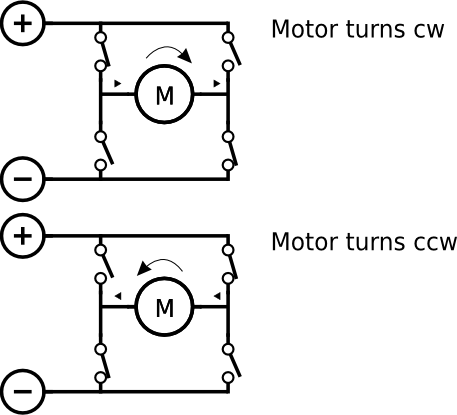No edit summary |
No edit summary |
||
| Line 6: | Line 6: | ||
== Links == | == Links == | ||
Circuit of an H-Bridge made of transistors, | |||
German Tutorial, connecting 2 Motors to an L293D: | |||
http://wiki.ctbot.de/index.php/L293D | |||
English Tutorial, connecting one Motor to an L293D: | |||
http://itp.nyu.edu/physcomp/Labs/DCMotorControl | |||
Circuit of an H-Bridge entirely made of separate components like transistors, free wheeling diodes (including shortage prevention): http://www.mikrocontroller.net/articles/H-Br%C3%BCcken_%C3%9Cbersicht | |||
[[Category:Electronics]] | [[Category:Electronics]] | ||
[[Category:Martin Schied]] | [[Category:Martin Schied]] | ||
Revision as of 15:30, 5 December 2011
An H-Bridge is a circuit of 4 switches allowing to select the direction of current flowing through a part. The simplest H-Bridge consists of four manually controlled switches:
When using a simple H-Bridge it is important to prevent switches to short the supply voltage. In commercially available H-Bridges additional circuits prevent accidental short circuits.
Links
German Tutorial, connecting 2 Motors to an L293D: http://wiki.ctbot.de/index.php/L293D
English Tutorial, connecting one Motor to an L293D: http://itp.nyu.edu/physcomp/Labs/DCMotorControl
Circuit of an H-Bridge entirely made of separate components like transistors, free wheeling diodes (including shortage prevention): http://www.mikrocontroller.net/articles/H-Br%C3%BCcken_%C3%9Cbersicht
